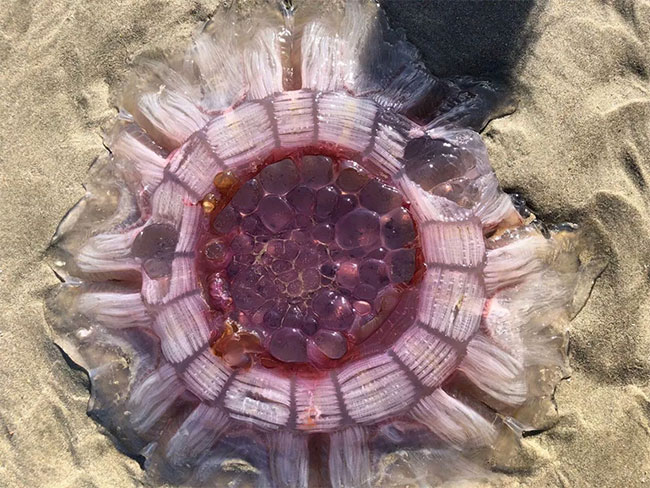Jellyfish like alien objects washed up on the coast of New Zealand
The mane of jellyfish with shallow strands is shaped like a volcano, the body is like a jelly in red pink color, attracting the attention of seafarers.
The Dickinsons family encountered a spherical object rising like a strange pink volcano on September 17 while strolling along Pakiri Beach in northern Auckland, New Zealand, according to Science Alert. Experts determined that this is a jellyfish named lion mane jellyfish, whose outer part is a fragmented white body and the inside of the pink pink color resembles plastic jelly.
"Jellyfish are everywhere and we are quite excited. We see this big jellyfish, it looks like it is different from all the surrounding people , " Eve Dickinson said. "We spend a lot of time looking at its beautiful colors and shapes. My son said the jellyfish reminded him of a volcano."

Jellyfish on Pakiri beach.(Photo: Science Alert).
Jellyfish mane (Cyanea capillata), also known as giant jellyfish or hair jellyfish , is more recognizable when floating underwater. Underneath its mushroom-shaped head, there were many long strands forming tentacles. But when it washed up on the shore, the body collapsed, making it look like an alien. Dickinson's family also saw the jellyfish move. " It looks like a bunch of muscles shrinking , " said Eve's husband, Adam.
Lion's mane jellyfish is the largest jellyfish known and living anywhere in the world, from the Arctic to Australia and New Zealand. They usually have a width of about 50cm. The largest specimen of the researcher ever found its way into Massachusetts Bay in 1870 with a diameter of 2.3 meters.
Marine biologist Diana Macpherson at New Zealand's National Water and Atmospheric Research Institute says lion mane jellyfish are quite common around islands, but appear less at the end of winter."They often show up in the spring and summer when plankton starts to grow," Macpherson said.
"They swung all the fish bait out at the same time. Each tentacle swung out to catch prey. They could find a lot of food through multitasking , " said Lisa-Ann Gershwin, a marine marine biologist. CSIRO National Science Agency of Australia.
Lions of lion lions like to eat plankton and other jellyfish. When floating in the water, they drove food with tentacles. They also act as an oasis for small fish and shrimp immune to venom, specializing in eating the remains of jellyfish. Jellyfish is the food of big fish and turtle-like sea turtles. Experts recommend that people should not touch the lion's mane on the beach because even if the burn does not cause serious injury, it can still cause you pain.
- The 'Muriwai Monster' was covered in the New Zealand coast
- The giant jellyfish washed over the English coast
- A mass of dead jellyfish covers the coast of New Zealand
- Strange objects like alien planets drifted to the US coast
- Photos of 'strange objects' on the ocean floor
- The first purple jellyfish on the planet
- The US coast is 'dyed' green because of thousands of jellyfish
- Billions of jellyfish-like creatures
- Giant jellyfish drifted off the coast of Australia
- Dragon-shaped skeleton washed up on the coast of New Zealand
- A billion green jellyfish washed over the US coast
- Giant squid washed up the coast of New Zealand
 Surprised: Fish that live in the dark ocean still see colors
Surprised: Fish that live in the dark ocean still see colors Japan suddenly caught the creature that caused the earthquake in the legend
Japan suddenly caught the creature that caused the earthquake in the legend A series of gray whale carcasses washed ashore on California's coast
A series of gray whale carcasses washed ashore on California's coast Compare the size of shark species in the world
Compare the size of shark species in the world